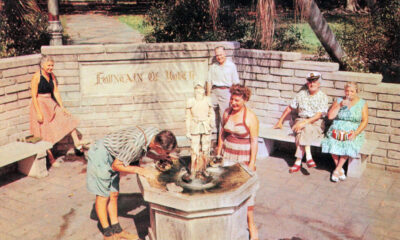Create
Vintage Pinellas: Making a ‘Strange’ movie in Gulfport
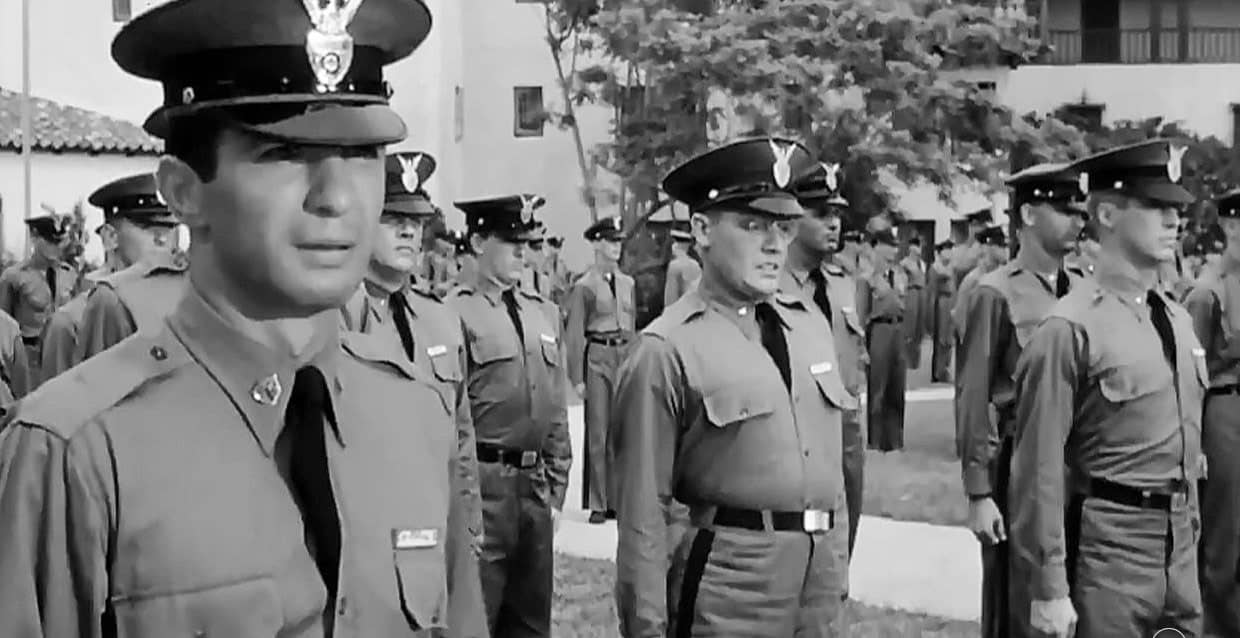
Gulfport’s stately Stetson University College of Law was a product of the 1920s Florida Land Boom. Developer I.M. “Handsome Jack” Taylor put up the Mediterranean Revival-style compound in the newly-created Pasadena Estates subdivision, cleverly naming his creation Hotel Rolyat – his surname spelled backwards.
According to history, Babe Ruth signed his 1932 contract with the New York Yankees in the hotel lounge.
That same year, the Rolyat was sold to the Florida Military Academy, which operated there until 1953, when the property was again sold, this time to DeLand’s Stetson University to expand its law school into a larger metropolitan area.
When Hollywood producer Sam Spiegel (The African Queen, On the Waterfront) needed an authentic southern military academy (or at least something that could pass for one) for his cinematic adaptation of Calder Willingham’s play End As a Man, his location people brought Stetson to his attention.
 Willingham had adapted the play from his novel, loosely based on his own experiences at The Citadel, South Carolina’s legendary military college. The play, starring newcomer Ben Gazzara and directed by Jack Garfein, had been a Broadway hit, and Spiegel – who was concurrently filming The Bridge on the River Kwai in Ceylon – arranged to shoot End As a Man in Florida’s hottest month, July. The year was 1956.
Willingham had adapted the play from his novel, loosely based on his own experiences at The Citadel, South Carolina’s legendary military college. The play, starring newcomer Ben Gazzara and directed by Jack Garfein, had been a Broadway hit, and Spiegel – who was concurrently filming The Bridge on the River Kwai in Ceylon – arranged to shoot End As a Man in Florida’s hottest month, July. The year was 1956.
Interiors would be lensed at a soundstage in Winter Park, near Orlando, while Stetson College of Law would pass for the story’s fictional academy for the all-important outdoor scenes of cadets drilling and marching in the squinting sun, and for the actors as they moved from one building to the other.
Spiegel brought his A-team, including Academy Award-winning Director of Photography Burnett Guffey (From Here to Eternity), and Art Director Joe Wright (The Man With the Golden Arm).
Like those films, End As a Man was to be a gritty, realistic portrait of something people in polite society didn’t talk about. The central character, cadet Jocko DeParis, is a sadistic upperclassman who bullies and humiliates his fellow students mercilessly.
Central to the plot is an incident in which Jocko (played by Gazzara) intimidates a couple of terrified freshmen into helping him get someone he simply doesn’t like – the son of an officer at the school – expelled for drinking on campus.
Gazarra, director Garfein and several other lead actors were from Lee Strasberg’s Actors Studio in New York; they were all imported directly from the Broadway production.
In June, the St. Petersburg Times announced that Spiegel and company were seeking locals to work as extras on the July 2-7 shoot:
The scenes here will require the services of 190 young men between the ages of 18 and 22 or, if big enough, boys of 16 or 17. They prefer men who have had military academy, National Guard or ROTC training.
Extras, who trained for a week prior to filming under the tutelage of retired Army colonel imported from Fort Lauderdale, were paid $3 per hour and given a box lunch.

Director Jack Garfein, right, works with actors Paul E. Richards (left) and Ben Gazzara on the Stetson lawn. The woman with the camera is actress Carroll Baker, Garfein’s wife, a former resident of St. Petersburg.
A 75-millimeter Civil War-era cannon was rented from a St. Petersburg homeowner, and placed on the Stetson lawn during the drill sequences – just another extra, to give the film a touch of authenticity. It was not fired.
St. Petersburg’s Hugh Doebrick, who was at that time a cadet at The Citadel, served as Garfein’s technical advisor, tweaking the actors’ motions as they impersonated military students.
Garfein was accompanied by his wife, actress Carroll (Baby Doll) Baker, who had lived for a time in St. Petersburg during her teenage years.
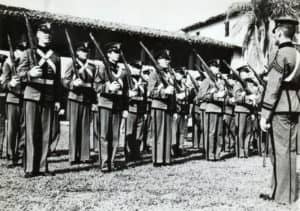
Columbia Pictures’ on-set publicity flack, George Nelson, told the Tampa Tribune that some changes were made to Willingham’s story. “Many of the extremely morbid aspects of the novel, a best-seller of several years ago, have been taken out of the movie,” the paper reported.

DeParis forces Simmons to shine his boots.
Most significantly, the play’s homoerotic subplot was almost completely excised; in the film, it is implied that DeParis’ seething hatred of freshman cadet Simmons (played onstage and onscreen by Arthur Storch) stems from the younger man’s effeminate nature.
The movie adds a scene in which DeParis “forces” Simmons to “go on a date” with a local floozy, played by Julie Wilson (also making her film debut). It’s conceivable, too, that Spiegel and Garfein had this tacked on simply to add a woman to the otherwise all-male cast, for broader box office appeal.
Then there’s Perrin, another young cadet targeted by DeParis. As played in the movie by Paul E. Richards, he is doe-eyed, soft-spoken and “artistic,” and therefore stereotypically gay. He is infatuated with the older student, who treats him reprehensibly.
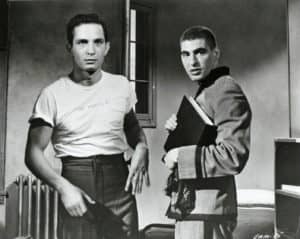
Poetry time: DeParis and Perrin (Gazzara and Richards).
In the movie, Perrin, who knows what’s happened, blackmails DeParis into … we never find out what. They have an uneasy interaction, during which Perrin reads his poetry aloud (“I have the fire of genius in me”) while DeParis fumes and waves his sword around. It’s a purposely uncomfortable scene, and typical of films of the era, its implication is left to the viewer.
In its June 5, 1957 review of the finished picture, the Village Voice bemoaned the excising, at the censor’s request, of three minutes of “vivid moments, especially those focusing on the homosexuality – scenes which truly earned excitement and applause when the picture was previewed at the Sheridan a few months ago.”
(It is unclear whether the poetry scene, which appears in the DVD version, was the same material excised from that first theatrical release.)
A significant book and stage subplot concerning De Paris’ father, a major contributor to school coffers, was also removed for the film. And the ending was completely changed.
The phrase “end as a man” never appears, so it may well have seemed logical for Spiegel to change the title. Before release, the film’s name was changed to The Strange One – another phrase that no one in the cast utters.
Was it because DeParis was “strange”? Or the things depicted were “not right”?
Or that the movie was, simply, hard to explain?
The PR wizards handling Columbia’s marketing campaign didn’t seem to know, either. The movie’s trailer begins with these words: The Strange One is a strange one.
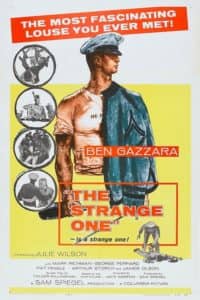 Writing in the New York Times, Bosley Crowther said that The Strange One delivered a diluted version of the central point of both the novel and the play, “the fact that brutalization and corruption of young men were ironically fostered and shielded by the ‘code of honor’ in existence at a Southern military school.” Instead, the critic complained, “Mr. Garfein in his direction has engendered an atmosphere of mystery and malevolence in the barracks that is appropriate to a minor horror tale.”
Writing in the New York Times, Bosley Crowther said that The Strange One delivered a diluted version of the central point of both the novel and the play, “the fact that brutalization and corruption of young men were ironically fostered and shielded by the ‘code of honor’ in existence at a Southern military school.” Instead, the critic complained, “Mr. Garfein in his direction has engendered an atmosphere of mystery and malevolence in the barracks that is appropriate to a minor horror tale.”
Over the decades the film achieved a semi-legendary status as a film noir, for its black and white photography and stark subject matter.
It’s never been considered a “classic,” even a minor one.
In an interview conducted for the 2009 DVD release, Gazzara explained that the film might have tanked because Columbia put all its marketing muscle into Spiegel’s other 1957 release, The Bridge on the River Kwai.
Spiegel, the actor said, had attempted to fire director Garfein from The Strange One, but let it go at the last minute. Their friendship never recovered, and Garfein’s filmmaking career ended shortly thereafter.
“When the picture was over, and cut and scored, Sam was finished,” explained Gazzara. “He never promoted it. There was no money for PR. It was thrown out there; there was no money for distribution. He just killed it. Long memory.”
This story appears in the book Vintage St. Pete & Vintage Pinellas Volume 3 (St. Petersburg Press).


